
The Project Gutenberg EBook of Lady Hollyhock and her Friends, by
Margaret Coulson Walker
This eBook is for the use of anyone anywhere in the United States and most
other parts of the world at no cost and with almost no restrictions
whatsoever. You may copy it, give it away or re-use it under the terms of
the Project Gutenberg License included with this eBook or online at
www.gutenberg.org. If you are not located in the United States, you'll have
to check the laws of the country where you are located before using this ebook.
Title: Lady Hollyhock and her Friends
A Book of Nature Dolls and Others
Author: Margaret Coulson Walker
Illustrator: Mary Isabel Hunt
Release Date: August 5, 2015 [EBook #49616]
Language: English
Character set encoding: UTF-8
*** START OF THIS PROJECT GUTENBERG EBOOK LADY HOLLYHOCK AND HER FRIENDS ***
Produced by Chris Curnow and the Online Distributed
Proofreading Team at http://www.pgdp.net (This file was
produced from images generously made available by The
Internet Archive) Music transcribed by Jude Eylander.

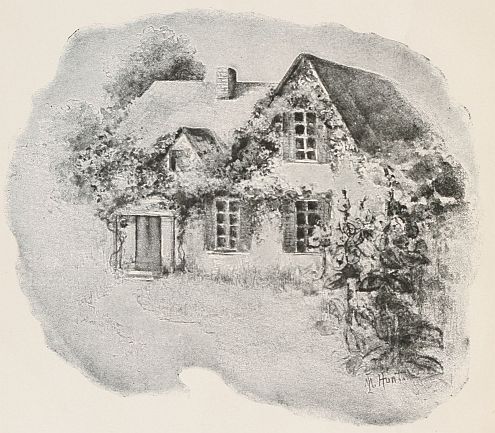
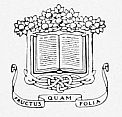
THIS book has a purpose beyond that of mere amusement. Its aim is to aid parents in furnishing not only entertainment but profitable employment as well, for their little ones—profitable, in that work under the guise of play, makes for character. The value of the things made is not in their finish, but in the training which they afford—a value ethical rather than intrinsic.
Children throw aside as uninteresting the finished toys from the shops when they have once learned to make playthings for themselves. To an imaginative child the possibilities of green things growing, of other materials provided by the changing seasons, and of the apparently useless trifles to be found in any home, are endless, and far surpass in permanent interest the realm of magic. In giving tangible form to the creatures imagined, thought is ripened into action and childhood’s natural desire for expressed imagery satisfied.
In making use of these apparently inappropriate materials in the construction of their own toys resourcefulness is engendered, practical intelligence stimulated, the inventive faculty cultivated, sympathetic acquaintance with nature broadened, and manual dexterity increased—all of which will later in life prove of inestimable value.
Then, too, such employment strengthens, or in some instances, creates the ability to get pure enjoyment out of the near at hand little things, which makes for permanent happiness.
The whole nature of a child cries out for self activity. Producing by his own efforts something that satisfies his[12] own needs gives him the keenest possible pleasure, and puts into him that energy which results in love of work.
There is no more interesting study for grown ups than that of children at play with dolls and animals of their own making. The more imaginative children prefer the flower dolls which fade or die quickly and then go to take their places in the sky to which they give the beautiful colors on sunset evenings. Others, natural little gad-a-bouts, always play “come to see,” while in some practical little souls the spirit of motherhood is so strong that, to them, every doll is a baby doll, and everything they play with, from a clothes-pin to a poker, must be mothered—sung to and cared for, petted and rocked.
Boys, with their more belligerent tastes, prefer to make Indians and soldiers out of the same materials that their sisters would convert into the most peaceful of citizens. Those in whom the sense of humor is strong make every face a comic one, while others put into the faces drawn by them the demure, trivial, or rugged features and expressions harmonizing with their ideas.
An effort has been made to furnish in these pages suggestions for all sorts and conditions of children. The songs and jingles are for those who like to make rhymes, or to sing about everything that they do.
Only a few of the dolls and animals children can make for themselves have been suggested. The possibilities of the subject are by no means exhausted.
Margaret Coulson Walker.
Des Moines, Iowa.
| PAGE | |
| Lady Hollyhock and Her Daughter | 21 |
| The Cucumbers | 24 |
| Radishes and Corn | 27 |
| The Radish Baby’s Song | 28 |
| Radish Babies | 31 |
| The Corn Lullaby | 32 |
| Pansies | 35 |
| Pansy Ladies | 36 |
| Poppy Maids | 39 |
| Poppy Lullaby | 40 |
| Acorn and Burdock Eskimos | 43 |
| Pigs | 46 |
| Burdock Leaves and Clothes-Pins | 49 |
| The Clothes-Pin Tribe | 50 |
| An Irish (Potato) Woman and Her Family | 54 |
| Creatures of Clay | 58 |
| A Man of Clay | 60 |
| The Corn Husk Lady | 61 |
| The Corn Cob Baby | 64 |
| Apple Jack | 66 |
| Apple Jack’s Story | 66 |
| The Peanut Man | 70 |
| The Peanut Chinese Woman | 72 |
| The Acorn Family | 74 |
| The Haws | 81 |
| The Gourds | 82 |
| Gourd Man | 84 |
| What the Gourd Man Said | 86 |
| The Mender | 89 |
| Hickory-Nut People | 90 |
| The Hickory-Nut Nurse | 92 |
| The Kelp Maiden | 94 |
| The Kelp Maid’s Song | 98 |
| Morning-Glory Ladies | 101[14] |
| Jack O’Lanterns | 102 |
| Pumpkin Pies | 104 |
| Jack O’Lantern Dreams | 105 |
| Rastus Prune | 106 |
| Dinah Prune | 108 |
| Pipe Dolls | 111 |
| Paper Dolls | 119 |
| Handkerchief Dolls | 122 |
| Pill-Box Dolls | 124 |
| The Straw Indian | 126 |
| The Dried Peach Indian | 128 |
| The Softening of the Snows | 130 |
| Pastry Creatures | 134 |
| The Doughnut Man | 136 |
| The Gingerbread Maid | 138 |
| The Yarn Child | 142 |
| Rag Dolls | 144 |
| Rag Babies | 146 |
| Tissue-Paper Ladies | 148 |
| Humpty-Dumpty | 151 |
| Cinderella’s Coach | 153 |
| PAGE | ||
| 1.— | Hollyhock Place | 4 |
| 2.— | Lady Hollyhock and Her Daughter | 20 |
| 3.— | Undressed Figures of Lady Hollyhock and Her Daughter.—(Corner piece) | 21 |
| 4.— | Lady Cucumber and Her Son.—(Corner piece) | 24 |
| 5.— | Lord Cucumber | 25 |
| 6.— | The Radish Baby.—(Corner piece) | 27 |
| 7.— | The Radish Baby | 29 |
| 8.— | The Corn Baby | 33 |
| 9.— | A Pansy Blossom.—(Corner piece) | 36 |
| 10.— | Pansy Ladies.—(Bottle bodies) | 37 |
| 11.— | Pansy Ladies.—(Paper bodies) | 38 |
| 12.— | Poppy Maids | 41 |
| 13.— | Burdocks in Fence Corner | 43 |
| 14.— | The Bur Eskimo | 45 |
| 15.— | Acorn Pig.—(Corner piece) | 46 |
| 16.— | Acorn Pigs in Pen | 46 |
| 17.— | Lemon Pigs | 47 |
| 18.— | A Clothes-Pin.—(Corner piece) | 49 |
| 19.— | The Clothes-Pin Tribe | 51 |
| 20.— | John and Priscilla Alden | 53 |
| 21.— | An Irish (Potato) Woman | 55 |
| 22.— | An Irish Pig | 57 |
| 23.— | A Clay Savage | 59 |
| 24.— | A Corn Husk | 61 |
| 25.— | Cornelia Shucks | 63 |
| 26.— | The Corn Cob Baby | 65 |
| 27.— | Apple Jack | 67 |
| 28.— | The Peanut Man | 71 |
| 29.— | The Peanut Chinese Woman | 73 |
| 30.— | Acorn Tops.—(Tailpiece) | 77 |
| 31.— | An Acorn Man | 75 |
| 32.— | An Acorn Woman | 79 |
| 33.— | The Haws | 81 |
| 34.— | A Long-Necked Gourd Man.—(Corner piece) | 82[16] |
| 35.— | The Weeping Gourd Man | 83 |
| 36.— | The Laughing Gourd Man | 85 |
| 37.— | The Gourd Man | 87 |
| 38.— | The Mender | 89 |
| 39.— | A Hickory-Nut Nun | 91 |
| 40.— | A Hickory-Nut Nurse | 93 |
| 41.— | Pelicans Standing on Kelp Beds at Sea.—(Tailpiece) | 96 |
| 42.— | The Kelp Maid | 97 |
| 43.— | Morning-Glory Ladies | 100 |
| 44.— | The Rainbow.—(Tailpiece) | 101 |
| 45.— | A Jack O’Lantern | 103 |
| 46.— | Rastus Prune | 107 |
| 47.— | Dinah Prune | 109 |
| 48.— | A Clay Pipe Baby | 110 |
| 49.— | Clay Pipe.—(Corner piece) | 111 |
| 50.— | A Clay Pipe Clown | 113 |
| 51.— | A Clay Pipe Old Lady | 115 |
| 52.— | A Clay Pipe Maiden | 117 |
| 53.— | Pattern for Paper Doll’s Dress and Hat | 120 |
| 54.— | A Paper Doll | 121 |
| 55.— | A Handkerchief Doll | 123 |
| 56.— | A Pill-Box Doll | 125 |
| 57.— | The Straw Indian | 127 |
| 58.— | The Dried Peach Indian | 129 |
| 59.— | The Proud Snows | 131 |
| 60.— | The Tender Snows | 133 |
| 61.— | A Pie-Crust Mule | 135 |
| 62.— | The Doughnut Man | 137 |
| 63.— | The Gingerbread Maid | 139 |
| 64.— | A Cooky Moon | 141 |
| 65.— | The Yarn Child | 143 |
| 66.— | A Rag Couple | 145 |
| 67.— | A Rag.—(Corner piece) | 146 |
| 68.— | A Rag Baby | 147 |
| 69.— | A Tissue-Paper Lady | 149 |
| 70.— | Humpty-Dumpty | 152 |
| 71.— | Peanut Cinderella.—(Corner piece) | 153 |
| 72.— | Cinderella in Her Coach | 154 |


Hollyhock Place was as beautiful a spot as children ever had for a home. Hollyhocks were blooming everywhere. All about the house and along the lane leading to it were great stalks bearing satiny blossoms of all shades, from delicate shell pink to the deepest, richest red. Besides, there were countless white and golden yellow ones.
When the little Wests came to live there it seemed like fairy land to them. All their lives they had lived in the city with its severe looking houses and hard brick and stone pavements. There their playthings, even, were made of wood and china and tin—all ready made and finished.
Here everything was so different. There were flowers and vines everywhere about their cottage home, shading the windows and trailing over the fences. In the garden at the back were beds of tender radishes and rows of tomatoes, cabbages, potatoes, corn and other vegetables, while over the fence grew vines bearing green and yellow gourds.
In the city the children had never seen these things growing; here they could not only see them, but could help them to grow, by watering them and stirring up the ground about their roots. And afterwards, they could have them for their very own. It was just the place to be perfectly happy in.
Cousin Charlotte was to live with them. She was fifteen and knew how to do many things to help children enjoy themselves. The little Wests thought it was because[22] she had always lived in the beautiful country. Perhaps it was.
She knew how to make the most wonderful dolls out of almost anything and could make rhymes and stories about them. The first doll she made for them Eugenie had named Lady Hollyhock. Eugenie had always liked stories of lords and ladies and knights and other great folk so the others were not at all surprised that their new visitor was a Lady.
A most wonderful lady she was with the daintiest of satiny gowns of the most beautiful shade of pink. In her hair—or on her head—she wore a bow of green, while round her neck was a great pointed green collar such as Queen Elizabeth might have envied. The pink and green were wonderfully becoming, for, being a lady of high degree and having excellent taste, she was careful in choosing colors which not only harmonized with each other, but with her complexion.
Lady Hollyhock’s complexion was a marvel—different from anything the children had ever seen in that line,—being a peculiar light shade of green. This was not to be wondered at though, when you know that Lady Hollyhock’s head was nothing but a green tomato, her body another, the green bow in her hair the stem and calyx of the tomato, and her collar the fuzzy double calyx of a hollyhock. Her gown—waist, sleeves and skirt—was of the beautiful flower cups of hollyhocks tied in at the waist by a long blade of grass.
Her piercing black eyes were glass headed pins, her nose a bit of a match, and her pearly teeth white headed pins. Tooth picks served for neck, arms and legs. Of these last it took three to support so great a personage.[23]
The daughter of this noble lady looked much like her mother though she was dressed somewhat differently. The face was the same but the cap and gown were just a little different. There was no sash about the waist of the daughter—her gown hung loose from the shoulders making her look younger. Having but one leg, this strange child was always compelled to stand with that in a slice of potato to keep from tumbling over.
After a time other members of the family joined these two—some wore gowns of red, some of white, and some of yellow, but none were more charming than the first Lady Hollyhock and her daughter.

During the summer and the winter following many friends visited with Lady Hollyhock and her family.
From Cucumber Hill came a most dignified Englishman. At a glance one knew him to be English for he wore a single eyeglass. A large brass headed furniture tack occupied the place of one eye while the other was filled by a small black carpet tack. Though a trifle stiff in his manners, this gentleman always wore an agreeable smile.
The lady who came with him could not be called beautiful. Her neck was too thick for that, but she smiled so pleasantly and wore such a becoming gown that one hardly noticed her neck. This gown was a loose flowing one of white. With her rather sallow, bumpy, green skin she could not have worn colors.
And the children from Cucumber Hill were much like their elders—a little stiff and awkward but so cheerful that they were always welcome.
After their visit, the members of this happy family were usually caught and devoured by Florence, Tom and Bunnie who played “Bear” sometimes to please Tom.
Like little Russians the children ate their cucumbers with the skins on, just as they would eat apples.[25]


The beautiful red radishes from the garden made the most charming of babies, with their leaves turned down for clothes and tied around with blades of grass. These and the corn babies were Florence’s favorites.
When the tender roasting ears were brought in from the garden the children all agreed that they were such dainty babies, just as they were, that it would spoil them to change them in any way.
All they needed to do was just to open the green husk a little and there lay the most beautiful creamy white Corn Baby wrapped in the daintiest of silken garments.
Florence hugged the Corn Baby close in her arms and as she rocked it to sleep sang to it a soft crooning little lullaby which she and the others had made up. Charlotte—and Mamma, too, had helped them a little with both the tune and words. As Florence sang to the baby in her arms the others joined her, singing softly always, and letting the song fade away almost to a whisper at the end that the baby might not miss the music when it was heard no more.
Then the Corn Baby was tenderly laid in a cradle Tom had made by gluing two semi-circles of wood for rockers to a pasteboard spool box. The wooden circle which he had cut in two had once had a bolt of ribbon wrapped around it in a store.
(Tune: “The Corn Lullaby”)

SOMETIMES Radish Babies too were put to sleep in spool box cradles, but more often they were eaten by their fond mothers, for Radish Babies were not only good to look at, and good to play with, but good to eat, as well.



Pansy dolls were made in several ways—and pansy verses with them. Of these dolls the easiest to make were the paper ones, folded and cut as all children cut rows of doll dresses. Then a small hole was cut in the top of each dress, and the pansy stem put into it. Without further work there stood a pansy lady with a paper body and blossom head.
Other pansy dolls were made by covering tiny pill bottles with grass blades, or leaves, putting one end of each leaf in the bottle, turning them all down, and tying them in place with a grass blade sash. When the bottle was filled with water and a pansy put into it, the children had a pansy lady who would live a day or two.
quoted Mamma when she was invited out to see a row of these visitors of Lady Hollyhock’s.[37]


GREAT beds of poppies grew at the end of the cottage at Hollyhock Place. To make poppy blossoms into dolls is the easiest thing in the world. All you have to do is to turn down the soft, silky petals, tie a blade of grass round them, and there you have a poppy maid, all finished and growing on a stem—a real flower fairy. There is a small green seed pod inside, you know, and that is the poppy maid’s head.
After making a number of these without breaking their stems the children often laid a cucumber, or radish baby in the poppy bed and sang to it a soothing lullaby—one they had made up themselves. Perhaps they had a little help—I cannot say as to that.
Poppies are the flowers that bring sleep you know.
Before long, the poppy maids would fade away and others would take their places. The dead ones were quietly buried near their friends, and soon after, at sunset, their colors were seen in the sky, as were those of many dead and gone, hollyhock and morning-glory ladies. None of these ever lived to be very old.

ALONG the orchard fence grew great broad leaved burdocks crowned with purplish pink tipped burs, which early in the season were made into all sorts of useful and beautiful objects—baskets, hanging baskets, cradles, sofas, chairs, tables and many other things.

In autumn, when the large acorns with fringed cups began to fall, the children gathered them and made them into Eskimos. One acorn was used for the body, and one for the head, with the point on the end for a nose. Twigs of the oak served for arms and legs.
The warmest of fur overcoats was made of the ripened burdock burs, while the furry fringed cup of the acorn made a cap that would have delighted the heart of any Eskimo.
Then Eskimo huts or igloos were made of the burs or “furs” as the children called them. Of course every one knows that real igloos are made of blocks of ice or snow,[44] not of fur, but ice was not to be had at that season of the year and would not have been comfortable to work with anyway.
As the bur Eskimo was in immediate need of a home the little Wests made him the very best one they could of the materials at hand. A very neat round hut was made of burs and that it might appear more real, both it and the ground were covered with cotton snow, making a real arctic landscape.[45]


“Why don’t you make animals as well as people out of fruits and vegetables, children?” said papa one day.
Why hadn’t they to be sure? They had never thought of such a thing, but when they did it was not long before the place was stocked with all sorts of strange animals.
The first piece of vegetable live stock the little Wests owned was a lemon pig which Uncle John made for them from a lemon, two white headed pins, and four matches.
With a knife a small gash was cut for a mouth; then ears were cut from the skin. These were left fastened to the lemon at the front edge.
Then pigs must have pens! So pens naturally followed—pens of corn cobs put together in rail fence fashion.
Later in the season there were acorn pigs in pens made of sticks and straws.



Burdock leaves as well as the burs were used by the children in their plays. Hats and shawls were made of them—but best of all were the burdock leaf wigwams.
To make these twigs or tent poles were stuck in the ground and burdock leaves folded round them in tent fashion. The points of the leaves were torn off to make them the right shape.
Then there had to be Indians to live in the wigwams and these were made of clothes-pins. Nothing could be easier to make than a clothes-pin Indian.
First the features are marked out on the head of the pin, then a band of paper pasted round the top and a feather stuck in at the back for a war-bonnet; and a square of stiff paper folded around the clothes-pin, for a blanket, and the Indian is finished.
The little Wests made whole villages of burdock wigwams with clothes-pin braves standing guard at the doors.
Tom always liked stories of enchantment, so he made up one about these wooden Indians.
JOURNEYING across the country a lone traveler chanced upon an Indian village. Such Indians as he saw there were unknown to him, and neither did he know that Indians of any kind dwelt in that part of the land.
Strange to him, too, were the wigwams, or teepees, of the unknown tribe. All of the wigwams with which he was familiar were covered with either blankets or skins. These were of the leaves of the burdock and much smaller than any he had ever seen—fit only for the homes of a pigmy tribe—and such it proved to be.
Guarding every wigwam stood an Indian, while others were scattered about the encampment.
As the traveler gazed on the scene before him, his astonishment grew when he saw that not a figure moved. Every man stood up straight and silent.
Inquiring of a passer-by, one who seemed acquainted with the regions round about, the traveler asked the meaning of what he saw, and learned that the pigmy tribe was ruled by a giant, who years ago had departed for a great city where he hoped to bargain with the people for the sale of the tobacco which his tribe produced. The sample he carried was in the form of a package of cigars, bound about by a strip of twisted tobacco leaves.
For the crime of tempting people to make use of that which would harm them the giant Indian and his pigmy tribe had had a spell cast over them, which turned them to wood, took away their speech, and rendered them motionless.
From the time when the spell came over them no Indian
[51]
[52]in all the tribe had so much as winked an eye. And all
would remain as they were till the spell was broken.

All stood just as they did at the moment when the enchantment fell upon them—the sentinels stock still at the doors of their tents, and the others stiff and straight in the places where that awful moment had found them; the giant chief stood just as he did on that day, ever holding out the package of cigars bound about by the twisted band of tobacco leaves.
When some paleface should take from the hand of the giant Indian the cigars which he offered, the spell would be broken, but to this day no such paleface had come.
This was the story Tom told Grandpa, the lone traveler, when asked about his clothes-pin Indian village with its burdock wigwams. And Grandpa said that it was no doubt true, for he, himself, had seen the giant Indian chief standing, wooden and silent, on a city street, offering cigars to every passer-by.
The Thanksgiving season brought to mind the other early settlers of America, and these, too, were represented by clothes-pin men and women, while the rude cabins of our forefathers were represented by corn cob cabins chinked with mud.
John Alden in his tall Pilgrim hat and Priscilla in her gown of gray and kerchief of white were favorite figures in these early history plays of the West children.[53]

SOME of the jolliest visitors were from the potato patch. They were Irish, of course, and every one knows how much fun there is in all Irish people. There was not a serious looking one in the whole family.
The mother had a most peculiar face, round and plump and happy, but deformed. Though she had more than the usual number of eyes, they were not located so she could use them as eyes.
One was on her cheek just where others sometimes have dimples, so she used that for a dimple. Another was on her forehead, and another just where an eye should have been for seeing purposes. But, sad to tell, this one had a sprout in it, and a sprout in the eye would ruin any one’s sight.
Had it not been for the little Wests, the Irish woman might have been blind all her life. With an ordinary lead pencil an operation was performed on her face which gave her a beautiful round eye just opposite the afflicted one.
This so pleased her that a broad smile spread over her face—a smile that she wore as long as she lived—and that was reflected in the faces of all of her family.
If you had asked her how it happened that they were always smiling, she would have said, “Sure, smiles are catching, just like measles.” When one in a family has them, they all do. Yes, they’re just as catching as measles, and much pleasanter to have.
Other potatoes were made up into gay Irish maidens, with early rose complexions, and into Irish men, with sun-browned faces, and into sturdy Irish children.[55]

These were able to stand up very nicely too, having good substantial Irish (potato) feet.
And who ever heard of an Irish family without a pig? And were not potatoes the most natural things in the world to make pigs of?
Nothing could have been easier to make. A long potato was the body, four matches the legs, two pins the eyes, while a curled dandelion stem made the most natural pig tail imaginable.
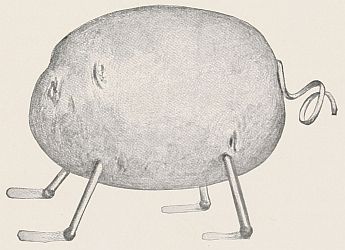
HAVE you ever made men and animals of mud? You can do almost anything with it when it is just soft enough. If it is too dry it is sure to crack. Clay is best, but any kind of mud will do.
The little Wests spent hours and hours making people and villages of clay—for there was a most delightfully damp bank by the brookside, where the clay seemed made for young artists.
After modeling a few men, the children began to notice just how large a head ought to be, for a certain sized body, and how far down the arms ought to reach, and whether the legs were longer or shorter than the arms.
At first, though, they made some funny looking creatures. Lady Hollyhock must have smiled more than ever when she saw two of them coming. Or maybe she was frightened.
One of them was a savage with excelsior hair standing out all over his head. The only clothing he wore was a skirt of leaves fastened about his clumsy waist.
His companion was a dwarf negro made by Ted, a larger playmate of the West children. Ted never would be serious. He told the children that the ugly dwarf had spoiled his looks by looking and listening too much. His looks certainly had been spoiled in some way.
Cousin Charlotte made a rhyme about him, which seemed to explain his appearance pretty well.[59]
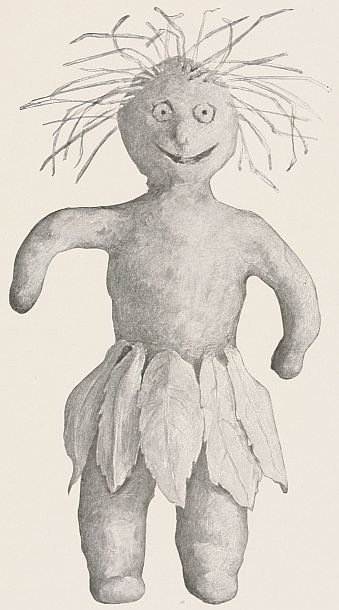
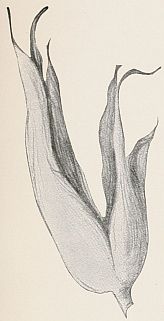
Through the mail one day the little Wests received a box bearing a Nebraska post mark. On opening it they saw the queerest doll imaginable, all neatly packed in crushed tissue paper.
This was a lady doll made entirely of corn husks and corn silk. The silk was for hair, of course, and very real looking hair it made. A bunch of the thinner, softer husks had been tied together for the head and body; a flat piece was laid over the place where the face was to be, and a string drawn tightly around it about an inch from the top making a very neat, shapely head and neck. Water color paints were used to make the clear blue eyes, rosy cheeks, and other features. Curly brown corn silk was next fastened on for hair, and t[62]wo rather stiff rolls of husks served for arms.
Then the lady was dressed in the most elaborate garments. She wore a gathered waist, large sleeves, and a very full skirt. On her head was a bonnet, wonderful to behold. Like her gown and parasol, it, too, was made entirely of corn husks.
A letter that came with the doll said that it had been made by a little crippled girl living on a Nebraska farm and who had made the husk dolls for amusement at first, but that since she had learned to make them so well many of her dolls had been sold. What she had begun for mere pleasure was now a source of profit to her.
The letter said, also, that in making her dolls this little girl always soaked the husks to soften them and to keep them from tearing while the dolls were being made.
In looking about for a name for the new visitor the children decided upon “Cornelia” as the name best suited to one of her nature and general makeup.
When Papa was asked to suggest a last name for the young lady from Nebraska he said he thought “Shucks” would probably be as appropriate as any other, so Cornelia Shucks she was called.
On the very day the young lady arrived the children hunted up some nice clean corn husks and put them to soak in warm water. There were thin white pieces which came next to the corn, and butter colored strips, and deep brown ones—variety enough for any doll’s wardrobe. After an hour or two of soaking, the husks were taken from the water and wiped as dry as possible and then they were ready.
After much examination of the fair Cornelia’s form and style of dress the little Wests were able to make quite respectable looking husk dolls. Of course, the first ones were a trifle clumsy, but after a while these children were able to make and dress lady dolls as fine as Cornelia Shucks herself.[63]

THE corn cob doll is a hardy little thing, able to endure the hardest usage.
It has no features, to speak of, and a dreadfully pock-marked face—yet no play baby is dearer to the heart of its owner than the corn cob baby.
Baby Bunnie gave her corn cob child a little more style than such babies usually have, by wrapping it about as babies are sometimes wrapped in foreign countries.
Red cobs were made into Indian babies, and bound into bark cradles, and hung up in the trees, like real papooses.[65]
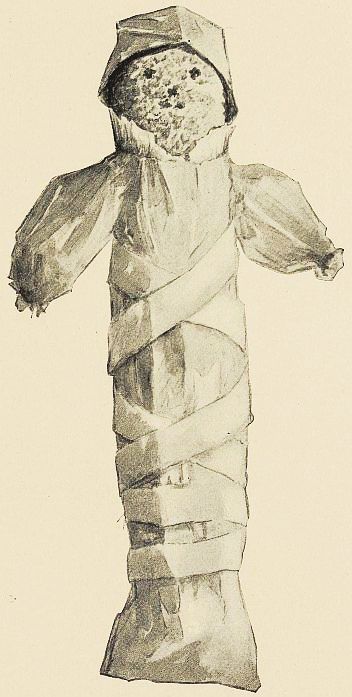
FROM the Orchard came Apple Jack, a most agreeable gentleman.
Lady Hollyhock was not the only person who was proud to receive him. Everybody liked him, not alone for his engaging smile and pleasant manner but because of his goodness.
Then he could always be depended upon to stand by his friends, and the advice he gave was always of the best.
But we will let him tell his own story.

THE Peanut Chinese man was made of eight peanuts—one for the head, one for the body, one for each arm and two for each leg. All had double kernels, except the one forming the head.
These peanuts were fastened together by heavy thread. The needle was run crosswise through the end of one nut; then through the end of the nut joining it, and the thread tied in a hard knot.
The face was drawn with a pen and ink. The back of the head and bottoms of the feet were solidly inked for hair and shoes and the cue was of braided black silk thread, sewed to the top of the head. Over the place where the cue was fastened, a disk of stiff paper was glued for a hat.
When crinkled tissue paper was gathered around the neck and arms to form a loose jacket and around the legs for wide trousers, the Peanut Chinese man was complete.[71]
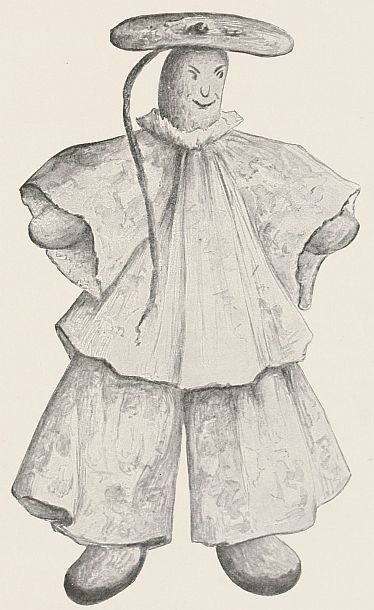
THE Peanut Chinese woman was not dressed like a real Chinese woman. Living in America, she was beginning to like skirt-like gowns better than the baggy trousers of her own people. Her sleeves, too, had just a little of the American look.
But when it came to dressing her hair the real Chinese style suited her best. The heavy black silky loops were caught up and held in place by long pins such as she had used in her native land.
Her garments, like those of the Peanut Chinese man, were of crinkled tissue paper, though the little Wests pretended they were of silk.
They wanted these dolls to have silk clothing like real Chinese people, but as they did not have the goods, they just imagined that the paper was silk and were happy in the make-believe.[73]
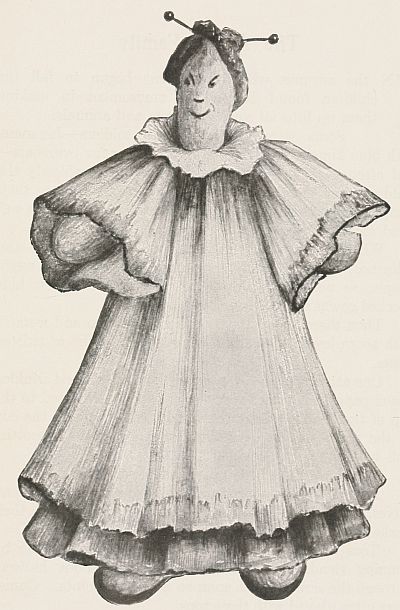
IN the autumn when the acorns began to fall the children found no end of amusement in making them up into all sorts of people and animals.
Some were converted into soldiers—Japanese, with blue kimonos and Russians with long fur overcoats—and often they were lined up for battle. Ruthlessly the children shot them down with bean shooters. Since their sympathies were with the Japs, of course the Russians suffered most, yet there were losses on both sides.
While the brown of the acorns suggested Japs and Filipenos, it was equally suggestive of our own negro people, so numbers of these were made with their blue checked gowns and red bandanas.
Then there were just ordinary acorn men and women, with acorn heads on toothpick necks, and bodies of twisted paper.
One attractive pair was dressed in corn-colored crinkled tissue paper. A round disk of the paper was pasted to the top of the head of each for the brim of a hat, and the cup of the acorn pasted over that for a crown. No prettier doll hats could be imagined.
The shoes these little people wore were of ink.
Everything the acorn family had was made, like themselves, of acorns. Their cups and saucers, their plates, their baskets, their tops, and their pigs, even, were of acorns.
Tom enjoyed the tops most. These were made by running slender toothpicks, or shoepegs, about halfway through the acorns which spun on their own points. Games were often played with these tops.[75]
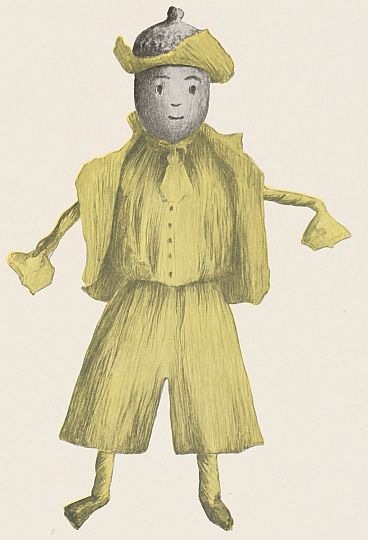
When any one wanted to know which army would be victorious in battle two tops were set spinning on a plate and each named for an opposing army. The one falling over first was defeated, of course. Sometimes one spun itself off the plate. That meant a retreat.
Disks of bright colored paper were often placed above the top on the toothpick or shoepeg. When red, orange, yellow, green, blue, and violet were used and all the tops set spinning at the same time, this meant that a rainbow had gone to pieces and each color was doing its best to get back into its proper place.

Note:
An acorn is used for the body of each of these dolls, and toothpick arms and legs inserted as in Apple Jack.
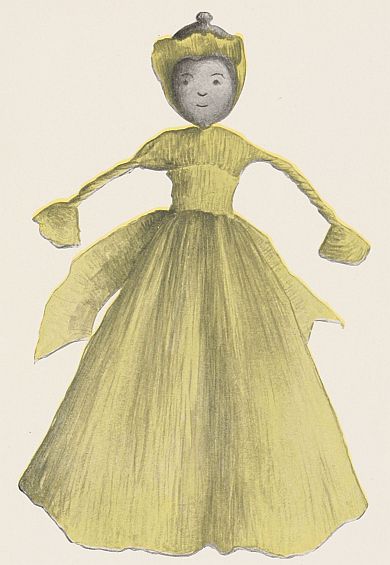
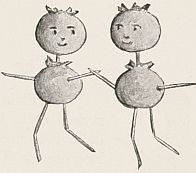
THE members of the Haw family were not very different from those of the Acorn family. Why should they be? They had lived side by side in the same wood all their lives, and had grown up together under the same circumstances.
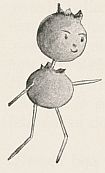
Their complexions were different, to be sure, but aside from this and the difference in the shape of their heads, they were built on exactly the same lines—round bodies, slender arms and legs.
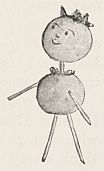
Like the Acorn family some had perfectly stiff limbs, while others were provided with joints. The first were supposed to have rheumatism.
The only wonder is that they did not all have it, going about as they did, without any clothes, in all sorts of weather.
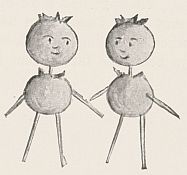
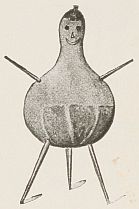
The little Wests each fancied a different style of doll. Eugenie liked dressed up visiting dolls, Florence played mother to baby dolls in long dresses, Tom liked what he called “funny fellows” and Indians, while baby Bunnie always insisted on her children keeping house.
Tom’s favorites, the funny fellows, came from the squash patch and gourd vines. It was not necessary to even dress these. All one had to do was to dip a match in ink and mark out faces on them.
These faces could be made either sunny and cheerful or sour and sad by changing the directions of the lines. Lines turning upward made the happy faces and those turning downward made the troubled ones.
The oval yellow gourds were made into fat men and Humpty Dumpties. These Tom used to make run races with each other by rolling them down hill. Which do you think always beat, the fattest and largest, or the smaller ones?
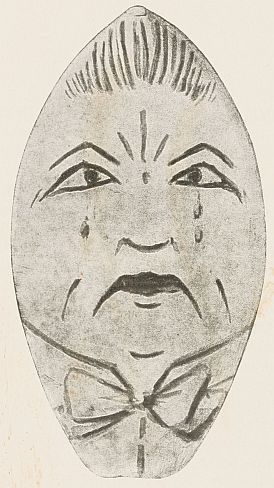
NONE of the Gourd men ever had the appearance of being either sensible or well behaved. But one ought not to expect sense and dignity from any of their race, for, all over the world, those who have neither are said to be as “green as a gourd.”
It was only the gourd babies who seemed to know anything at all about behaving properly. Strange as it may seem, the younger members of this awkward family were as sweet and quiet as any babies in the whole vegetable kingdom.
Some of these gourd children were made by using the large part for a head and putting a deep frill about the neck for a gown. This was held in place by a pin run through both gown and baby.
Others were made by using the slender part for a head and putting the same kind of a frill about the neck for a dress. The last kind could sit up as well as any real child.
It was the easiest thing in the world to make rhymes about these dolls—indeed the rhymes seemed to almost make themselves.[85]
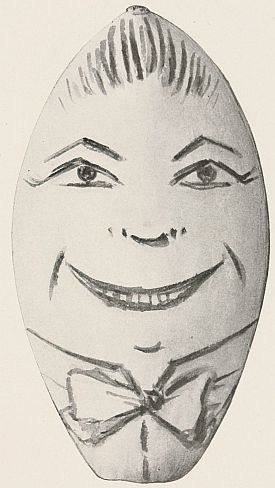

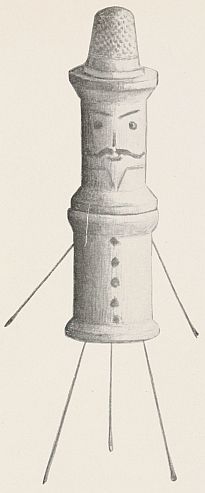
A STRANGE creature made of spools, a thimble, and needles was called “The Mender.” But it was not because he ever really did any mending. He never did anything but stand where he was put, in the stiffest way imaginable.
Even though he never did do anything, he was of some use in the world, for his very presence seemed to say, “A stitch in time saves nine.”
HICKORY nuts were rather hard to make into dolls, for it was almost impossible to make their heads stay on. But by putting close fitting caps on them under their bonnets, and bringing the cloth down and tying it at the neck with a string, this extended cap made a very good foundation for a body.
It was found that bonnets and long capes were the most becoming garments for these dolls, as they seemed to harmonize best with the caps.
Since Nuns and Nurses both dress in this way, the greater number of the Hickory-nut family turned out to be Nuns and Nurses.[91]
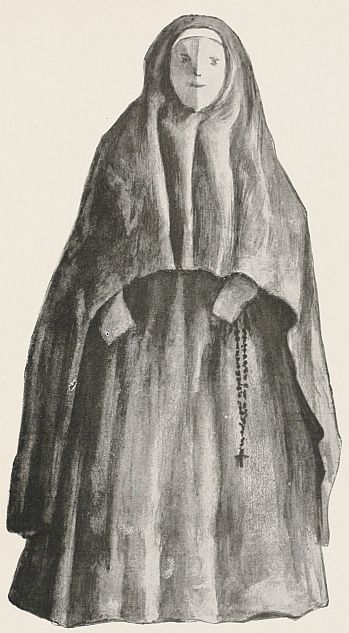
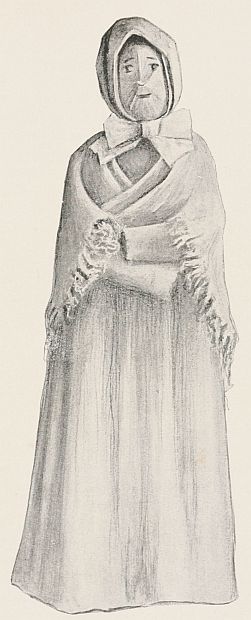
IN August Uncle John came all the way from California to make a visit at Hollyhock Place. The little Wests never tired of hearing him tell of the wonderful things that grew in that western land—of trees higher than church spires—of sea-gulls and pelicans—and of the queer California Woodpecker that bores holes in the trunks of dead trees and pounds an acorn into each hole for future use.
As the family sat out under the trees this jolly old uncle of theirs seemed to take as much interest in the funny home-made dolls as the children themselves did. It was he who showed them how to make the great fat-faced Humpty Dumpties out of the oval yellow “darning gourds” as Mamma called them.
And what fun they had making jingles—Uncle John and the little Wests. Songs he called them, and they were, too, for a tune always came with the words when he made them.
When their uncle left to go back to his California home the children missed him greatly and watched eagerly for the letter he promised them when he reached home. Two whole weeks passed before the letter arrived. When it came there was a small package with it.
What was in the package? There is no need to tell, the letter will explain. Here is the letter which made the children laugh as much as if Uncle John himself had been there telling them what he had written. Charlotte played and sang the song for them till they all learned it. But as I said, here is the letter:[95]
San Diego, Calif.,
September 1st, 1906.
My Dear Nieces and Nephew:—
This morning as I passed a bake-shop and glanced in at the window, the cakes and buns seemed to laugh and wink at me with the fat faces of their bakers.
The doll I send you today was made of kelp by a little California girl. Kelp is a heavy leathery sort of sea-weed that washes ashore about here. There are great beds of it off the coast of California. It grows so thickly that it gives the water a brown appearance and the long leathery leaves are strong enough to bear up pelicans and other sea-birds that one often sees apparently standing on the water. Visitors to California often take home beautiful baskets and other things woven from strips of this strong leathery weed, which is brown on the outside and creamy white inside.
This little kelp maiden I got for you several days ago and as I have watched her standing on the mantel-piece with that dissatisfied look on her face, she seemed to sing this song to me, and as I listened I seemed to hear the plash and feel the rolling of the waves which used to rock her to sleep out on the kelp beds at sea.[96]
I wonder if it will seem the same to you? I know she will be a warning to you against discontent which is sure to spoil the pleasure of anyone if it is allowed to get into his life.
I am hoping that the little kelp maid may grow cheerful through associating with Lady Hollyhock and her friends. They all have happy faces as I remember them—as happy as those of three cheery little nieces and a jolly little nephew of
Your affectionate,
Uncle John.
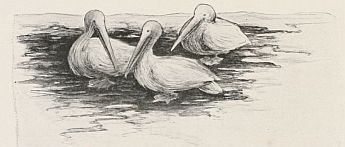
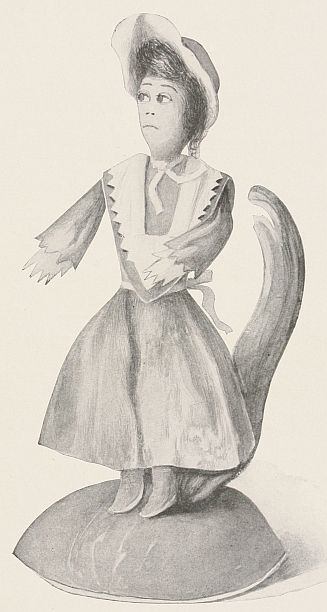
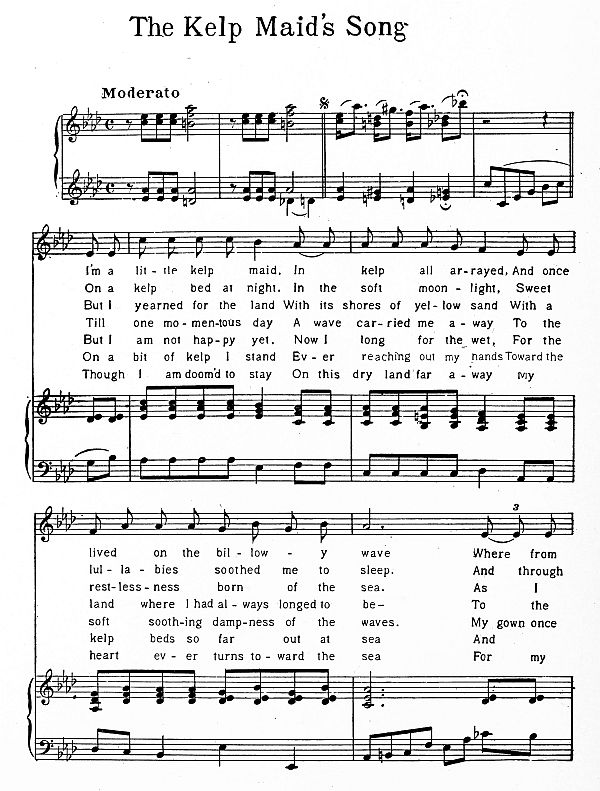
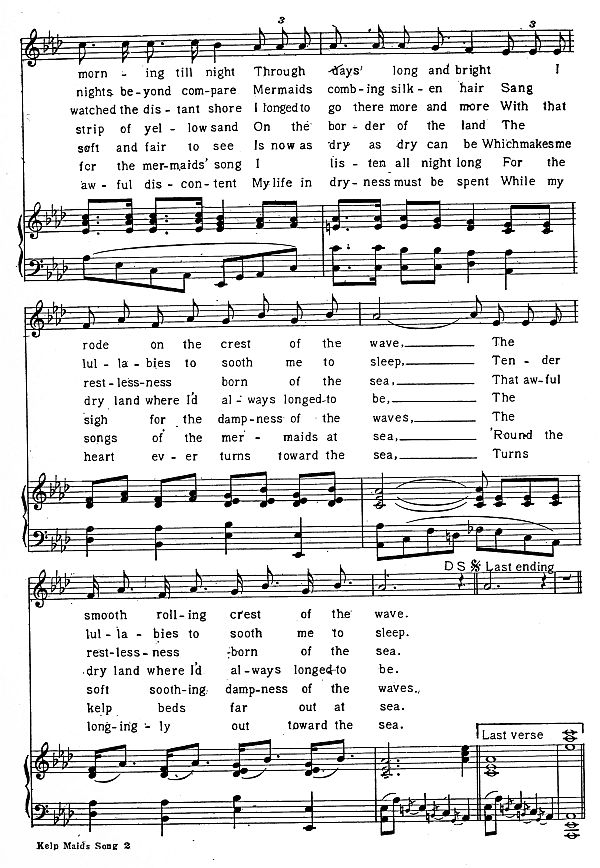
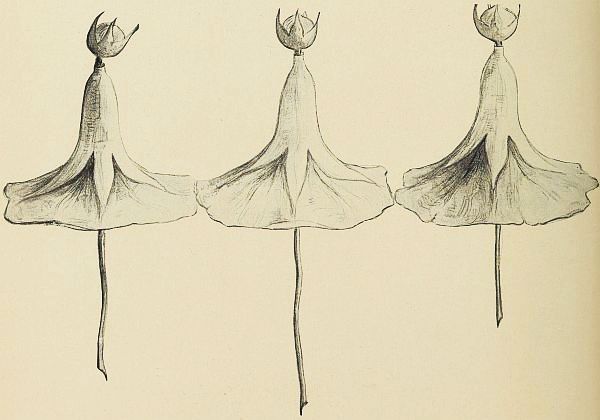
MORNING-GLORY ladies were made by slipping a flower cup upside down over the stem of a seed pod, leaving the pod for a head. Morning-glory ladies always died young. Indeed, they hardly lived at all.
The spirits of these lost flower children were not only seen in the sunset skies but in the rainbow, too. And when the little Wests saw the great, beautiful bow in the sky, they always repeated the words of old Nokomis to Hiawatha:
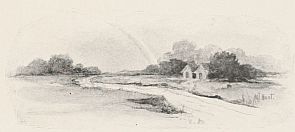
THE children planted pumpkin seeds early in the season and hoed and cared for the vines themselves, that they might have their own pumpkins for Hallowe’en, and what fun they had with them! And how delightfully scarey they were, when made into Jack O’Lanterns! Some one said they were pumpkin ghosts.
Two dreadful ones were placed on the gate posts to frighten Papa when he came home after dark. He guessed right away who had put them there.
Others were carried about on poles with sheets hanging about them, in solemn procession.[103]
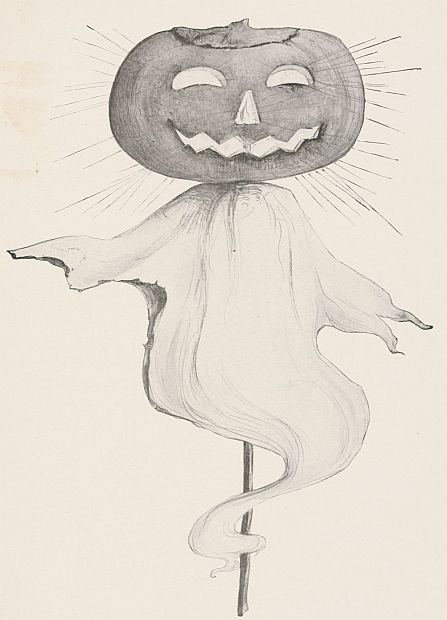
NOT all of the pumpkins were used for Jack O’Lanterns, though. Some were given to Mamma to make into delicious pumpkin pies.
Poor little Tom ate too much of the pies, and his greediness made him have frightful dreams and a terrible pain in his stomach.
The verses Cousin Charlotte and the others made about his dream made greedy Tom feel very much ashamed.
RASTUS was a peculiar looking negro, with wrinkled face and goggle eyes.
Paper teeth with a red lip line running around them were fitted into a wrinkle of his prune face and fastened by a touch of mucilage. His paper eyes were fastened on in the same way.
With a light paper vest neatly fitted over his prune body and a paper collar round his peg neck he was as neat a colored gentleman as could be found anywhere.
Then his chamois-skin suit with hat to match, gave him such style as any one might be pleased to copy.
His checked trousers were his special pride, for they never bagged at the knees or got out of shape in any way. On this account he was perfectly satisfied to be a peg-leg.
His feet, though, gave him some trouble. They were always getting out of shape. Being made of raisins, an ordinary step was likely to make them swing round and look as though they would prefer to take him the other way.
But Rastus smiled on, thinking, no doubt, that this apparent deformity would prove a great convenience when it came to dancing a “backstep.”[107]
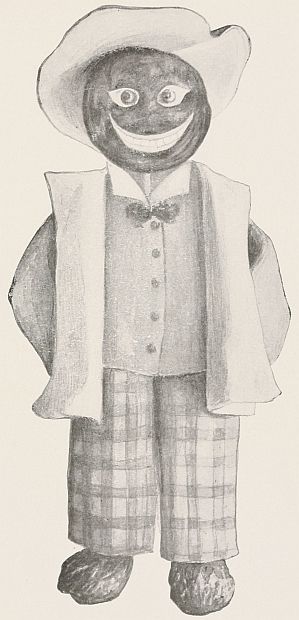
DINAH, the mother of Rastus, was just a plain sensible colored woman, wearing a dark gown, and a bandana head dress.
Like most colored women of her age, she always wore a neat kerchief folded across her breast, and a large apron to protect her gown.
Though she was no beauty, she was good. All who knew her liked her, and the same might be said of her son.
Like him, she was made of prunes and toothpicks, and stood on raisin feet.[109]
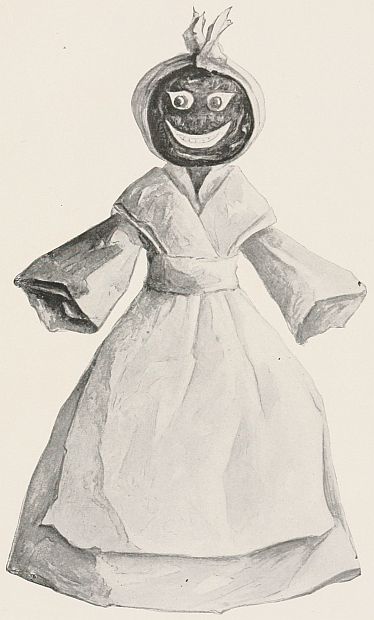
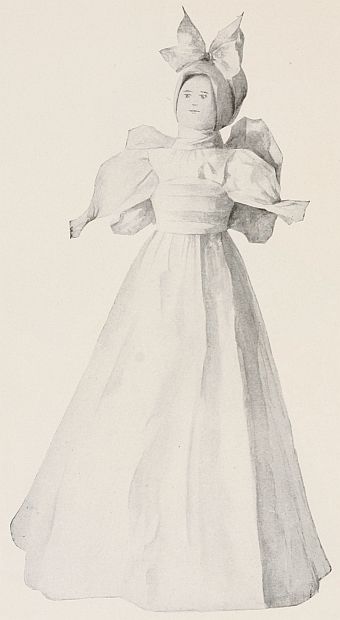
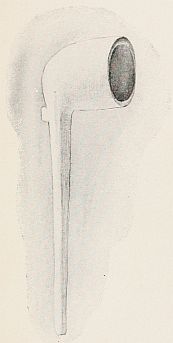
Not all the dolls made by these children were of fruits, flowers and vegetables. In fact it was a poor scrap that they could not make into a satisfactory plaything. And not only the little Wests enjoyed them but Mamma was just as much interested in the making as were the children themselves.
One evening a little party of friends was gathered together at Hollyhock Place and for amusement Mamma gave each a clay pipe, a lead pencil, a square of white and a square of colored tissue paper and requested each guest to dress the pipe for a doll.
To some this, at first, seemed impossible. One or two gentlemen asked to be excused, but when they saw the others meeting with such success they, too, became interested and went to work. Nearly all used needles and thread, but a few were most successful with mucilage to hold their materials together.
It was funny to see the different expressions on those pipe faces. No two of them looked the least bit alike.
The minister’s wife did not use her colored paper at all, but from the white she made a long baby dress with a big bow in the back and a white cap with another big bow was made to cover the head. This baby had the tiniest little eyes, nose and mouth you could imagine.[112]
Another lady made a clown of her pipe, using orange paper for his clown suit and pasting white circles all over it. This was a neater clown than one ever seeks in a circus, for he wore the freshest of white ruffles at his neck, wrists and ankles. The bump at the bottom of the pipe made the funniest of chin whiskers for this queer creature who could not keep from laughing at himself—and no wonder.[113]
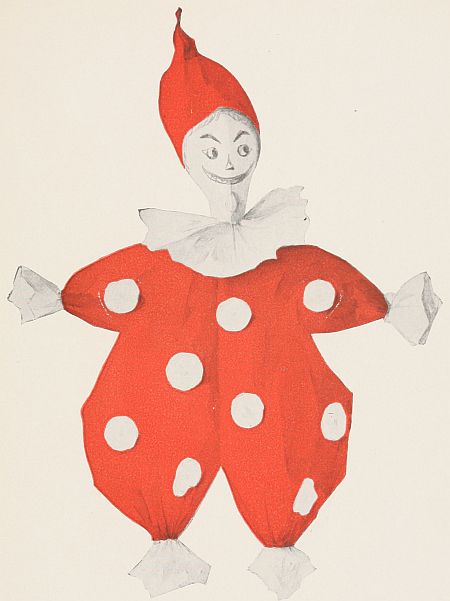
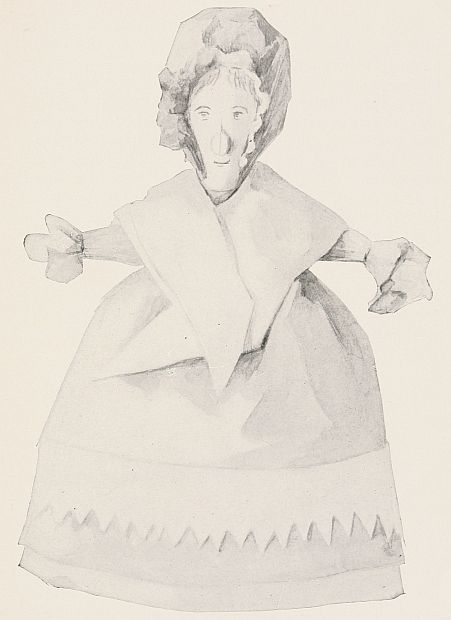
One of the ladies made her pipe into an old lady doll with folded kerchief and great tall cap. In this one the bump at the bottom of the pipe served as a nose—a large, ill shaped one to be sure, but a very good nose for all that.
A very dignified gentleman who was present said he always liked to see a lady wear a sun-bonnet, so he drew a face inside of his pipe and made lines outside for “slats” that used to be put in old fashioned sun-bonnets. A woman who would wear a sun-bonnet would, of course, wear an apron, so a large white apron was put on this doll. Her face was a pretty one, but her hands were large and clumsy, showing that she had done hard work in her day.
These last two dolls wore several full petticoats which enabled them to stand up like real people.
There were a number of other good ones, but why tell you about them, for I am sure you can make some just as good as the best of these.[117]
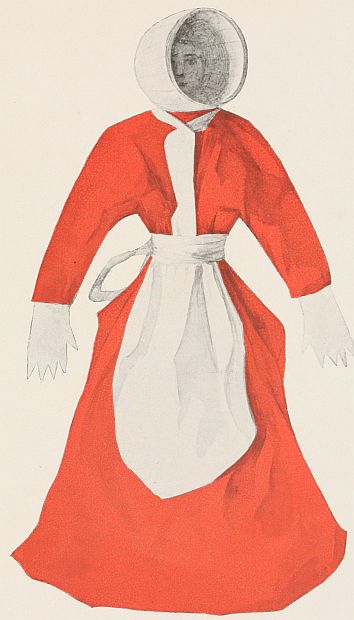
THE paper dolls were more like real people than any of the others. They were made by cutting heads from colored picture cards or from magazines and pasting them on cardboard bodies. Then double dress patterns were folded and cut to slip over the heads of the dolls, and on these patterns were pasted gowns of tissue paper in all colors and styles.
The children were very particular about dressing their dolls in good taste, for they knew that by making neat, sensible doll clothes, they would learn how to dress themselves tastefully when they grew older.
The little girl dolls wore either plain gingham dresses with fresh white aprons, or simple white gowns. Their hats were plain, without feathers or flowers, as little girls’ hats should be.
Lady dolls wore dresses that were more elaborate. The colors in these always harmonized.[120]
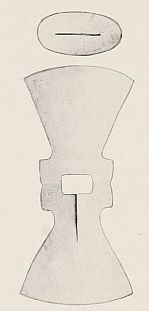
Pattern for paper doll’s dress and hat. The cut across the oval cardboard hat pattern fits over the top of the doll’s head.[121]
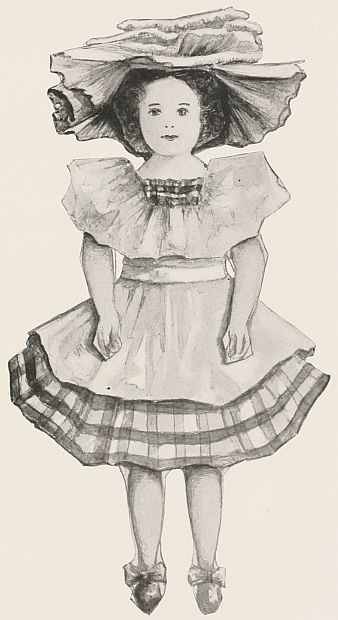
NO collection of make-believe would be complete without the handkerchief doll.
Surely she is a simple child, just an ordinary handkerchief rolled from each side toward the center, then the top turned down, and the corners pulled out and tied around the body for arms, leaving a stuffy little head at the top, and a long skirt at the bottom.
The handkerchief doll’s little brother is made to look a trifle different from her, by having the lower corners of the handkerchief, of which he is made, pulled out for feet.
Towel dolls are larger members of the same family.[123]
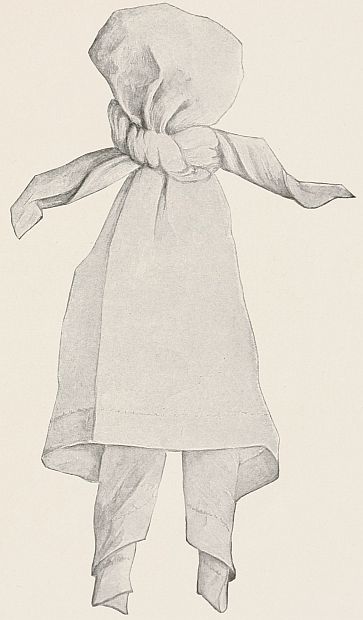
ONE of Baby Bunnie’s especial favorites was the handkerchief doll made over a round pill box. With a pencil a face was marked out on the box and around this a handkerchief was folded three-cornerwise and pinned under the chin.
On dress occasions this little one wore around her neck a pretty fresh ribbon tied in a large bow with long ends. Could a more dainty child be found anywhere?[125]
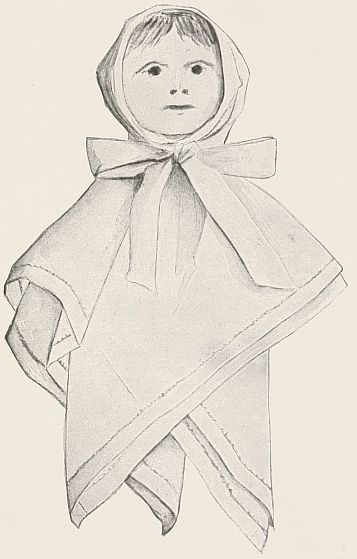
LADY HOLLYHOCK’S visitors differed greatly in many ways. It was not only in looks that they varied, but in their very natures. And strange to say, many were different from what they seemed.
Some who appeared bravest and strongest were the weakest. For instance, who would have thought, to look at the fierce appearing Straw Indian, in all the bravery of war-bonnet and blanket, that he was one of the weakest of them all?
It was not his fault, poor fellow. He really wanted to be brave and strong. He showed that in both manner and dress. But with his weak constitution, how could he ever have gone into battle with the braves of his tribe? It had always been impossible for him to stand up for himself, even, without something to lean on.
He tried to make up for his natural weakness by dressing and acting like a brave, but it was useless.
Exercise, which makes others grow strong, only made the poor Straw Indian weaker, and while he was yet young his constitution gave way and he was laid to rest by the little Wests, who loved him in spite of his weakness, beside others of his tribe.
After the manner of real Indians he was buried in a sitting position, down in the orchard, near the clothes-pin Indian village.
However frail he may have been in life, now that the friendly earth supported him, none sat straighter than the lamented Straw Indian.[127]
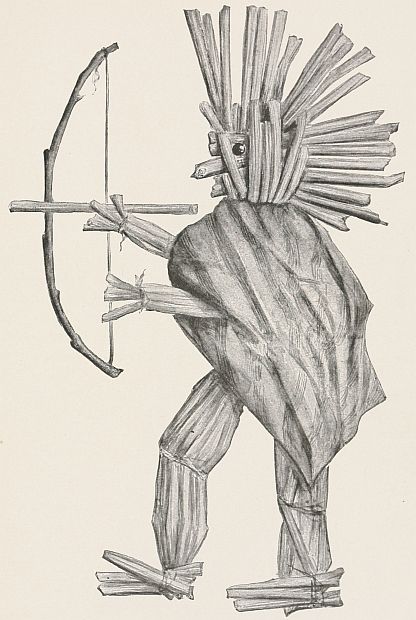
THE Dried Peach Indian was just as different as could be from the Straw Indian. Being both strong and brave, he went out and did great deeds, as you can see by his war-bonnet.
If he had been just an ordinary Indian brave, he would have had only two or three eagles’ feathers at the back of the band encircling his head.
But as every feather in an Indian’s war-bonnet means some great deed done, any one can see the Dried Peach Indian had led a busy life.[129]
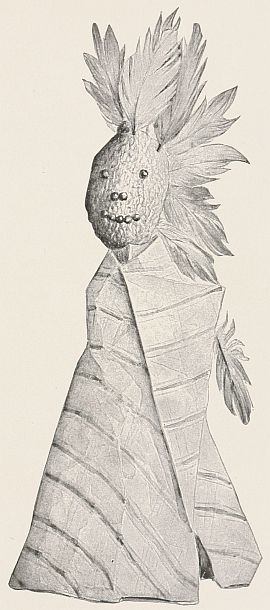
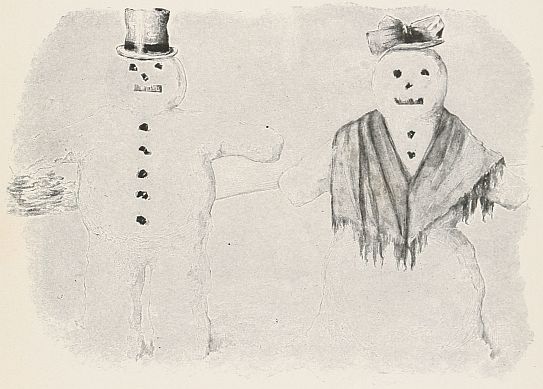
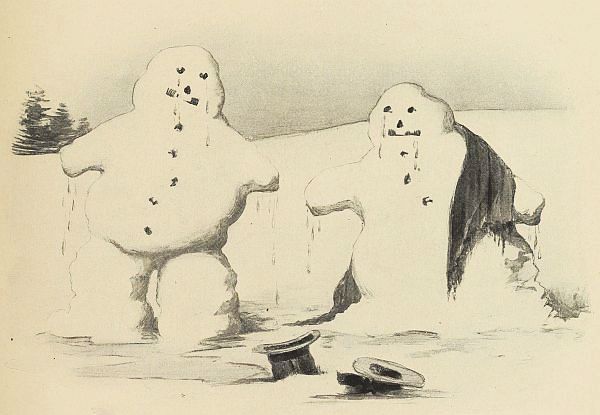
BUT of all Lady Hollyhock’s visitors, the little Wests enjoyed most those who came from the kitchen.
When baking day came, Mamma always allowed the children to have a little pastry dough to make up into the forms they liked best.
Pie crust was fashioned into all sorts of animals as well as into people. These kept their shape beautifully.
Doughnut creatures, though good to have, were likely to lose their shapeliness as they grew in the fat. They did not suffer long, however, for they were soon eaten.
The story of the Doughnut Man was always sung as one of these odd creatures disappeared.
Sweetest of all were the Gingerbread Maids. It always took a pan full of these favorites to satisfy the children. Verses were made about these, too, and often repeated.[135]
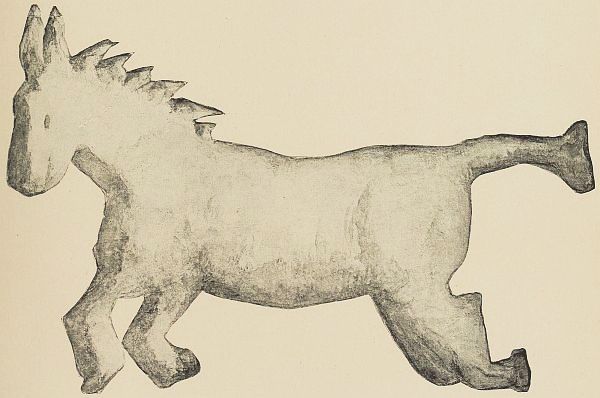
(Tune: Old Grimes is Dead)
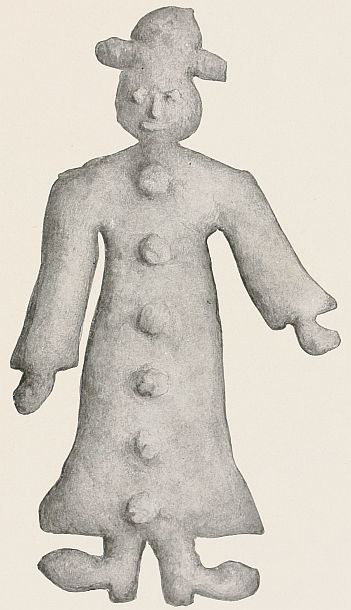
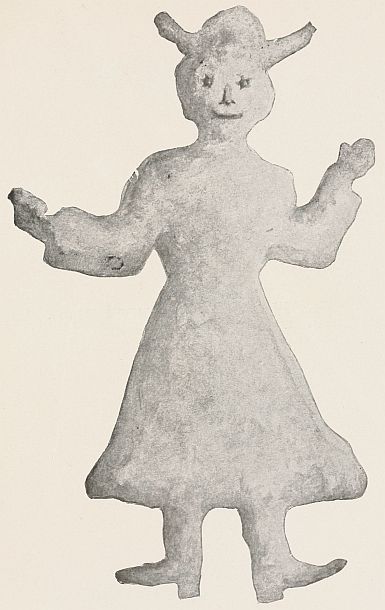
The great round cooky moons were fine, too. Cooky dough seemed made on purpose for modeling.[141]
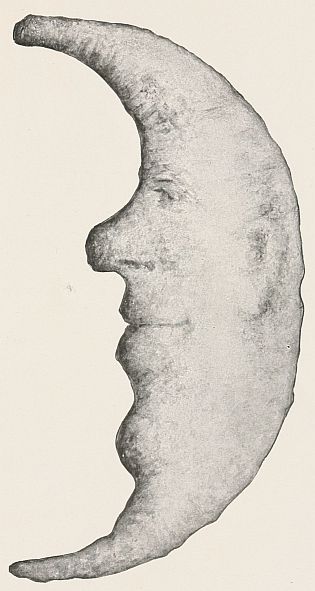
THE yarn child had a hard time in the world. You would not think it to look at her, but she did.
The very first day of her life she was given to a baby who was so fond of her that he bit her, and tried to pull her to pieces; then squeezed and hugged and picked at her till it was a wonder she ever lived through it all—Lady Hollyhock never could have endured such treatment.
But the yarn child did. Her main business in life was to amuse that baby, and, no matter how she was treated, her yarn eyes were just as wide open and her yarn smile just as broad as if she had always had the best of treatment.[143]
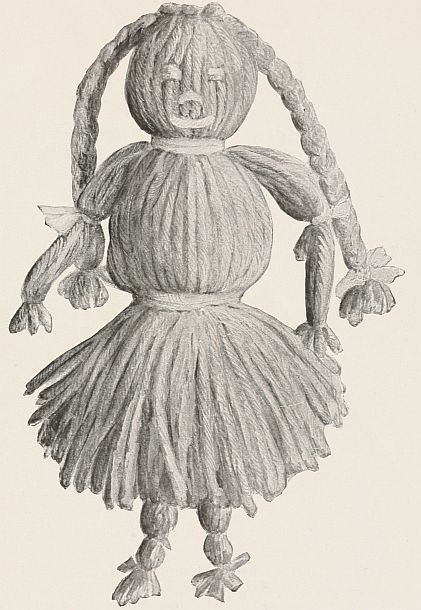
AT Lady Hollyhock’s all visitors were treated alike. Those who came in rags were just as welcome as any.
Here is one pair, Mr. and Mrs. Dry Goods, who came all in rags even to their faces. Indeed, they appeared so well that one hardly thought of their garb until attention was called to it.
They were just as neat and clean as could be, though every part of them, from bodies to bonnets, had come out of the rag-bag.
These rag people were made by first taking a small wad of cotton wool for the head of each and covering it with thin brown silk drawn tightly together at the back, where knots of black thread were made to look quite like hair.
The features were drawn with a sharp pencil on each brown face while a stitch of white thread between the lips did very nicely for teeth. A small stitch of white was used in each eye, also.
Tight rolls of cloth served for the bodies, arms, and legs. When these were sewed securely together, the little rag couple were ready to be dressed.
As real people in dressing put on stockings and shoes first, these rag people did the same. The stockings they wore were cut from worn-out black silk gloves and sewed neatly up the back. The shoes and mittens were made from old kid gloves and fastened on with a few stitches.
Then the rag couple were dressed quite like other dolls, very neatly, of course, for the little Wests did everything neatly.[145]
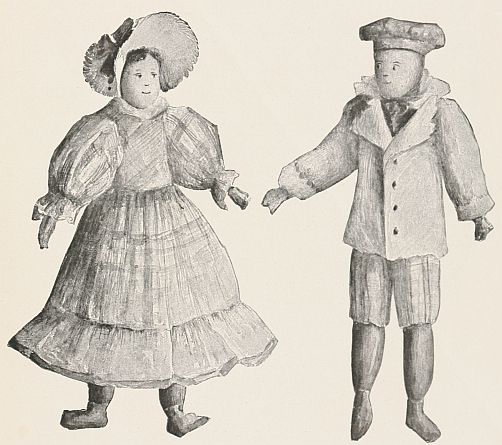

Then there were the rag babies—I almost said the little rag people—but that would not have been true, for strange to say the babies were larger than the older members of the family.
This does not seem so strange after all, when one stops to think, for in the whole rag world, everything grows smaller as it grows older.
Some of these were just ordinary white babies while others belonged to the colored race. The Topsies were made of brown cotton or silk, with faces done in water colors, and hair of French knots.
But no matter what their color, or how they were made, the rag babies probably got more real love from their owners than any other dolls in the whole collection.
Rag babies are made by folding a piece of paper lengthwise and cutting the pattern of a half body free hand. This will insure the two sides being alike.
After getting a good pattern, cut from muslin two pieces just alike for front and back, sew them together and stuff with cotton.
The features can be made with either water colors or common ink thinned a little.[147]
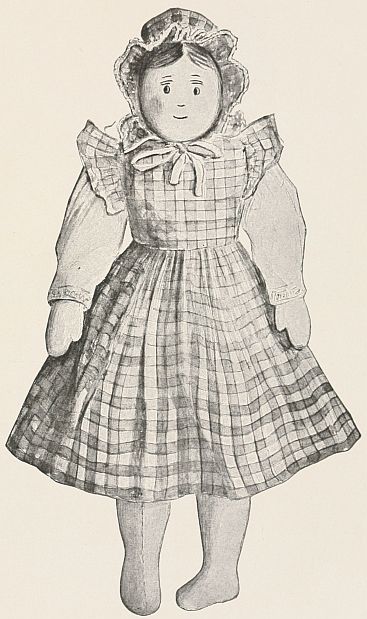
OTHER tissue-paper ladies were made by gluing an upright strip of wood to the center of a horizontal piece, like an inverted T, and wrapping it with cotton for a foundation.
A ball of cotton was fastened to the top for a head, then covered with white tissue paper on which a face was drawn with a pencil.
These ladies wore loose, flowing gowns, long capes, and large, comfortable bonnets tied under the chin.
Tissue-paper ladies of this kind could stand alone.[149]
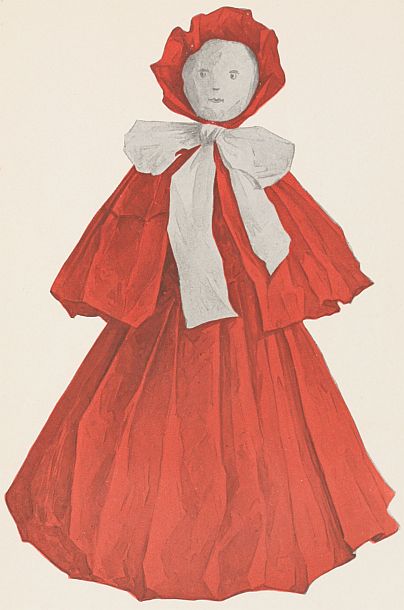
HUMPTY-DUMPTY was made from an empty egg shell. First, holes were carefully picked in the shell and the egg blown out. Then the face and cap were drawn in ink on the shell.
Wires covered with dark tissue paper were then put through the holes and bent into shape for arms and legs.
If light-weight hair pins are used, two or three may be twisted together for legs and spread at the ends to form feet. These dolls can stand alone.[152]
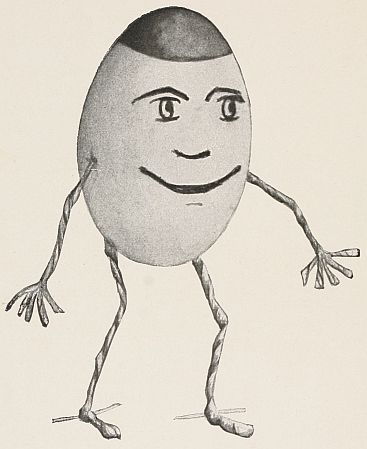
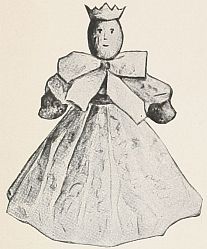
“I wish a fairy godmother would come and make a Cinderella’s coach for us out of this squash,” said Baby Bunnie one day.
“We can be our own fairy godmother,” said little Florence, as she set to work to make the wish come true. Soon there stood before them a wonderful coach made of that very squash—drawn by handsome peanut horses—and in it rode a beautiful peanut Princess, while a little dark raisin footman with toothpick arms and legs rode at the back on a seat cut out for him. A hairpin was the axle which held the pasteboard wheels in place.
The Princess was to drive straight to Lady Hollyhock’s, where the footman would assist her in leaving the carriage.
You, too, can be your own fairy godmother, and if you wish to have a great ball, at which all of Lady Hollyhock’s visitors may appear, not through the touch of a wand, but through the touch of the hand—and all of them will be so real that they will not fade away when the Princess goes.
Would it not be best, after all, for every one of us to be our own fairy godmothers, so that when we want very much to have anything happen we can set things going to bring it about? Then the things wished for will not vanish away at the stroke of a clock, but will be ours always.
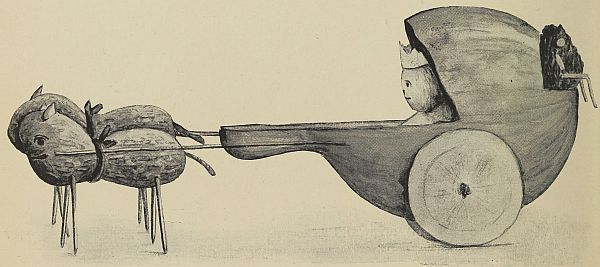

Obvious punctuation errors repaired.
Page 50, “bargin” changed to “bargain” (hoped to bargain with)
Page 74, “acrons” changed to “acorns” (acorns which spun)
Page 134, “crus” changed to “crust” (Pie crust was formed)
End of the Project Gutenberg EBook of Lady Hollyhock and her Friends, by
Margaret Coulson Walker
*** END OF THIS PROJECT GUTENBERG EBOOK LADY HOLLYHOCK AND HER FRIENDS ***
***** This file should be named 49616-h.htm or 49616-h.zip *****
This and all associated files of various formats will be found in:
http://www.gutenberg.org/4/9/6/1/49616/
Produced by Chris Curnow and the Online Distributed
Proofreading Team at http://www.pgdp.net (This file was
produced from images generously made available by The
Internet Archive) Music transcribed by Jude Eylander.
Updated editions will replace the previous one--the old editions will
be renamed.
Creating the works from print editions not protected by U.S. copyright
law means that no one owns a United States copyright in these works,
so the Foundation (and you!) can copy and distribute it in the United
States without permission and without paying copyright
royalties. Special rules, set forth in the General Terms of Use part
of this license, apply to copying and distributing Project
Gutenberg-tm electronic works to protect the PROJECT GUTENBERG-tm
concept and trademark. Project Gutenberg is a registered trademark,
and may not be used if you charge for the eBooks, unless you receive
specific permission. If you do not charge anything for copies of this
eBook, complying with the rules is very easy. You may use this eBook
for nearly any purpose such as creation of derivative works, reports,
performances and research. They may be modified and printed and given
away--you may do practically ANYTHING in the United States with eBooks
not protected by U.S. copyright law. Redistribution is subject to the
trademark license, especially commercial redistribution.
START: FULL LICENSE
THE FULL PROJECT GUTENBERG LICENSE
PLEASE READ THIS BEFORE YOU DISTRIBUTE OR USE THIS WORK
To protect the Project Gutenberg-tm mission of promoting the free
distribution of electronic works, by using or distributing this work
(or any other work associated in any way with the phrase "Project
Gutenberg"), you agree to comply with all the terms of the Full
Project Gutenberg-tm License available with this file or online at
www.gutenberg.org/license.
Section 1. General Terms of Use and Redistributing Project
Gutenberg-tm electronic works
1.A. By reading or using any part of this Project Gutenberg-tm
electronic work, you indicate that you have read, understand, agree to
and accept all the terms of this license and intellectual property
(trademark/copyright) agreement. If you do not agree to abide by all
the terms of this agreement, you must cease using and return or
destroy all copies of Project Gutenberg-tm electronic works in your
possession. If you paid a fee for obtaining a copy of or access to a
Project Gutenberg-tm electronic work and you do not agree to be bound
by the terms of this agreement, you may obtain a refund from the
person or entity to whom you paid the fee as set forth in paragraph
1.E.8.
1.B. "Project Gutenberg" is a registered trademark. It may only be
used on or associated in any way with an electronic work by people who
agree to be bound by the terms of this agreement. There are a few
things that you can do with most Project Gutenberg-tm electronic works
even without complying with the full terms of this agreement. See
paragraph 1.C below. There are a lot of things you can do with Project
Gutenberg-tm electronic works if you follow the terms of this
agreement and help preserve free future access to Project Gutenberg-tm
electronic works. See paragraph 1.E below.
1.C. The Project Gutenberg Literary Archive Foundation ("the
Foundation" or PGLAF), owns a compilation copyright in the collection
of Project Gutenberg-tm electronic works. Nearly all the individual
works in the collection are in the public domain in the United
States. If an individual work is unprotected by copyright law in the
United States and you are located in the United States, we do not
claim a right to prevent you from copying, distributing, performing,
displaying or creating derivative works based on the work as long as
all references to Project Gutenberg are removed. Of course, we hope
that you will support the Project Gutenberg-tm mission of promoting
free access to electronic works by freely sharing Project Gutenberg-tm
works in compliance with the terms of this agreement for keeping the
Project Gutenberg-tm name associated with the work. You can easily
comply with the terms of this agreement by keeping this work in the
same format with its attached full Project Gutenberg-tm License when
you share it without charge with others.
1.D. The copyright laws of the place where you are located also govern
what you can do with this work. Copyright laws in most countries are
in a constant state of change. If you are outside the United States,
check the laws of your country in addition to the terms of this
agreement before downloading, copying, displaying, performing,
distributing or creating derivative works based on this work or any
other Project Gutenberg-tm work. The Foundation makes no
representations concerning the copyright status of any work in any
country outside the United States.
1.E. Unless you have removed all references to Project Gutenberg:
1.E.1. The following sentence, with active links to, or other
immediate access to, the full Project Gutenberg-tm License must appear
prominently whenever any copy of a Project Gutenberg-tm work (any work
on which the phrase "Project Gutenberg" appears, or with which the
phrase "Project Gutenberg" is associated) is accessed, displayed,
performed, viewed, copied or distributed:
This eBook is for the use of anyone anywhere in the United States and
most other parts of the world at no cost and with almost no
restrictions whatsoever. You may copy it, give it away or re-use it
under the terms of the Project Gutenberg License included with this
eBook or online at www.gutenberg.org. If you are not located in the
United States, you'll have to check the laws of the country where you
are located before using this ebook.
1.E.2. If an individual Project Gutenberg-tm electronic work is
derived from texts not protected by U.S. copyright law (does not
contain a notice indicating that it is posted with permission of the
copyright holder), the work can be copied and distributed to anyone in
the United States without paying any fees or charges. If you are
redistributing or providing access to a work with the phrase "Project
Gutenberg" associated with or appearing on the work, you must comply
either with the requirements of paragraphs 1.E.1 through 1.E.7 or
obtain permission for the use of the work and the Project Gutenberg-tm
trademark as set forth in paragraphs 1.E.8 or 1.E.9.
1.E.3. If an individual Project Gutenberg-tm electronic work is posted
with the permission of the copyright holder, your use and distribution
must comply with both paragraphs 1.E.1 through 1.E.7 and any
additional terms imposed by the copyright holder. Additional terms
will be linked to the Project Gutenberg-tm License for all works
posted with the permission of the copyright holder found at the
beginning of this work.
1.E.4. Do not unlink or detach or remove the full Project Gutenberg-tm
License terms from this work, or any files containing a part of this
work or any other work associated with Project Gutenberg-tm.
1.E.5. Do not copy, display, perform, distribute or redistribute this
electronic work, or any part of this electronic work, without
prominently displaying the sentence set forth in paragraph 1.E.1 with
active links or immediate access to the full terms of the Project
Gutenberg-tm License.
1.E.6. You may convert to and distribute this work in any binary,
compressed, marked up, nonproprietary or proprietary form, including
any word processing or hypertext form. However, if you provide access
to or distribute copies of a Project Gutenberg-tm work in a format
other than "Plain Vanilla ASCII" or other format used in the official
version posted on the official Project Gutenberg-tm web site
(www.gutenberg.org), you must, at no additional cost, fee or expense
to the user, provide a copy, a means of exporting a copy, or a means
of obtaining a copy upon request, of the work in its original "Plain
Vanilla ASCII" or other form. Any alternate format must include the
full Project Gutenberg-tm License as specified in paragraph 1.E.1.
1.E.7. Do not charge a fee for access to, viewing, displaying,
performing, copying or distributing any Project Gutenberg-tm works
unless you comply with paragraph 1.E.8 or 1.E.9.
1.E.8. You may charge a reasonable fee for copies of or providing
access to or distributing Project Gutenberg-tm electronic works
provided that
* You pay a royalty fee of 20% of the gross profits you derive from
the use of Project Gutenberg-tm works calculated using the method
you already use to calculate your applicable taxes. The fee is owed
to the owner of the Project Gutenberg-tm trademark, but he has
agreed to donate royalties under this paragraph to the Project
Gutenberg Literary Archive Foundation. Royalty payments must be paid
within 60 days following each date on which you prepare (or are
legally required to prepare) your periodic tax returns. Royalty
payments should be clearly marked as such and sent to the Project
Gutenberg Literary Archive Foundation at the address specified in
Section 4, "Information about donations to the Project Gutenberg
Literary Archive Foundation."
* You provide a full refund of any money paid by a user who notifies
you in writing (or by e-mail) within 30 days of receipt that s/he
does not agree to the terms of the full Project Gutenberg-tm
License. You must require such a user to return or destroy all
copies of the works possessed in a physical medium and discontinue
all use of and all access to other copies of Project Gutenberg-tm
works.
* You provide, in accordance with paragraph 1.F.3, a full refund of
any money paid for a work or a replacement copy, if a defect in the
electronic work is discovered and reported to you within 90 days of
receipt of the work.
* You comply with all other terms of this agreement for free
distribution of Project Gutenberg-tm works.
1.E.9. If you wish to charge a fee or distribute a Project
Gutenberg-tm electronic work or group of works on different terms than
are set forth in this agreement, you must obtain permission in writing
from both the Project Gutenberg Literary Archive Foundation and The
Project Gutenberg Trademark LLC, the owner of the Project Gutenberg-tm
trademark. Contact the Foundation as set forth in Section 3 below.
1.F.
1.F.1. Project Gutenberg volunteers and employees expend considerable
effort to identify, do copyright research on, transcribe and proofread
works not protected by U.S. copyright law in creating the Project
Gutenberg-tm collection. Despite these efforts, Project Gutenberg-tm
electronic works, and the medium on which they may be stored, may
contain "Defects," such as, but not limited to, incomplete, inaccurate
or corrupt data, transcription errors, a copyright or other
intellectual property infringement, a defective or damaged disk or
other medium, a computer virus, or computer codes that damage or
cannot be read by your equipment.
1.F.2. LIMITED WARRANTY, DISCLAIMER OF DAMAGES - Except for the "Right
of Replacement or Refund" described in paragraph 1.F.3, the Project
Gutenberg Literary Archive Foundation, the owner of the Project
Gutenberg-tm trademark, and any other party distributing a Project
Gutenberg-tm electronic work under this agreement, disclaim all
liability to you for damages, costs and expenses, including legal
fees. YOU AGREE THAT YOU HAVE NO REMEDIES FOR NEGLIGENCE, STRICT
LIABILITY, BREACH OF WARRANTY OR BREACH OF CONTRACT EXCEPT THOSE
PROVIDED IN PARAGRAPH 1.F.3. YOU AGREE THAT THE FOUNDATION, THE
TRADEMARK OWNER, AND ANY DISTRIBUTOR UNDER THIS AGREEMENT WILL NOT BE
LIABLE TO YOU FOR ACTUAL, DIRECT, INDIRECT, CONSEQUENTIAL, PUNITIVE OR
INCIDENTAL DAMAGES EVEN IF YOU GIVE NOTICE OF THE POSSIBILITY OF SUCH
DAMAGE.
1.F.3. LIMITED RIGHT OF REPLACEMENT OR REFUND - If you discover a
defect in this electronic work within 90 days of receiving it, you can
receive a refund of the money (if any) you paid for it by sending a
written explanation to the person you received the work from. If you
received the work on a physical medium, you must return the medium
with your written explanation. The person or entity that provided you
with the defective work may elect to provide a replacement copy in
lieu of a refund. If you received the work electronically, the person
or entity providing it to you may choose to give you a second
opportunity to receive the work electronically in lieu of a refund. If
the second copy is also defective, you may demand a refund in writing
without further opportunities to fix the problem.
1.F.4. Except for the limited right of replacement or refund set forth
in paragraph 1.F.3, this work is provided to you 'AS-IS', WITH NO
OTHER WARRANTIES OF ANY KIND, EXPRESS OR IMPLIED, INCLUDING BUT NOT
LIMITED TO WARRANTIES OF MERCHANTABILITY OR FITNESS FOR ANY PURPOSE.
1.F.5. Some states do not allow disclaimers of certain implied
warranties or the exclusion or limitation of certain types of
damages. If any disclaimer or limitation set forth in this agreement
violates the law of the state applicable to this agreement, the
agreement shall be interpreted to make the maximum disclaimer or
limitation permitted by the applicable state law. The invalidity or
unenforceability of any provision of this agreement shall not void the
remaining provisions.
1.F.6. INDEMNITY - You agree to indemnify and hold the Foundation, the
trademark owner, any agent or employee of the Foundation, anyone
providing copies of Project Gutenberg-tm electronic works in
accordance with this agreement, and any volunteers associated with the
production, promotion and distribution of Project Gutenberg-tm
electronic works, harmless from all liability, costs and expenses,
including legal fees, that arise directly or indirectly from any of
the following which you do or cause to occur: (a) distribution of this
or any Project Gutenberg-tm work, (b) alteration, modification, or
additions or deletions to any Project Gutenberg-tm work, and (c) any
Defect you cause.
Section 2. Information about the Mission of Project Gutenberg-tm
Project Gutenberg-tm is synonymous with the free distribution of
electronic works in formats readable by the widest variety of
computers including obsolete, old, middle-aged and new computers. It
exists because of the efforts of hundreds of volunteers and donations
from people in all walks of life.
Volunteers and financial support to provide volunteers with the
assistance they need are critical to reaching Project Gutenberg-tm's
goals and ensuring that the Project Gutenberg-tm collection will
remain freely available for generations to come. In 2001, the Project
Gutenberg Literary Archive Foundation was created to provide a secure
and permanent future for Project Gutenberg-tm and future
generations. To learn more about the Project Gutenberg Literary
Archive Foundation and how your efforts and donations can help, see
Sections 3 and 4 and the Foundation information page at
www.gutenberg.org
Section 3. Information about the Project Gutenberg Literary Archive Foundation
The Project Gutenberg Literary Archive Foundation is a non profit
501(c)(3) educational corporation organized under the laws of the
state of Mississippi and granted tax exempt status by the Internal
Revenue Service. The Foundation's EIN or federal tax identification
number is 64-6221541. Contributions to the Project Gutenberg Literary
Archive Foundation are tax deductible to the full extent permitted by
U.S. federal laws and your state's laws.
The Foundation's principal office is in Fairbanks, Alaska, with the
mailing address: PO Box 750175, Fairbanks, AK 99775, but its
volunteers and employees are scattered throughout numerous
locations. Its business office is located at 809 North 1500 West, Salt
Lake City, UT 84116, (801) 596-1887. Email contact links and up to
date contact information can be found at the Foundation's web site and
official page at www.gutenberg.org/contact
For additional contact information:
Dr. Gregory B. Newby
Chief Executive and Director
gbnewby@pglaf.org
Section 4. Information about Donations to the Project Gutenberg
Literary Archive Foundation
Project Gutenberg-tm depends upon and cannot survive without wide
spread public support and donations to carry out its mission of
increasing the number of public domain and licensed works that can be
freely distributed in machine readable form accessible by the widest
array of equipment including outdated equipment. Many small donations
($1 to $5,000) are particularly important to maintaining tax exempt
status with the IRS.
The Foundation is committed to complying with the laws regulating
charities and charitable donations in all 50 states of the United
States. Compliance requirements are not uniform and it takes a
considerable effort, much paperwork and many fees to meet and keep up
with these requirements. We do not solicit donations in locations
where we have not received written confirmation of compliance. To SEND
DONATIONS or determine the status of compliance for any particular
state visit www.gutenberg.org/donate
While we cannot and do not solicit contributions from states where we
have not met the solicitation requirements, we know of no prohibition
against accepting unsolicited donations from donors in such states who
approach us with offers to donate.
International donations are gratefully accepted, but we cannot make
any statements concerning tax treatment of donations received from
outside the United States. U.S. laws alone swamp our small staff.
Please check the Project Gutenberg Web pages for current donation
methods and addresses. Donations are accepted in a number of other
ways including checks, online payments and credit card donations. To
donate, please visit: www.gutenberg.org/donate
Section 5. General Information About Project Gutenberg-tm electronic works.
Professor Michael S. Hart was the originator of the Project
Gutenberg-tm concept of a library of electronic works that could be
freely shared with anyone. For forty years, he produced and
distributed Project Gutenberg-tm eBooks with only a loose network of
volunteer support.
Project Gutenberg-tm eBooks are often created from several printed
editions, all of which are confirmed as not protected by copyright in
the U.S. unless a copyright notice is included. Thus, we do not
necessarily keep eBooks in compliance with any particular paper
edition.
Most people start at our Web site which has the main PG search
facility: www.gutenberg.org
This Web site includes information about Project Gutenberg-tm,
including how to make donations to the Project Gutenberg Literary
Archive Foundation, how to help produce our new eBooks, and how to
subscribe to our email newsletter to hear about new eBooks.